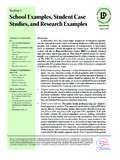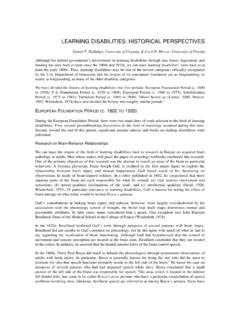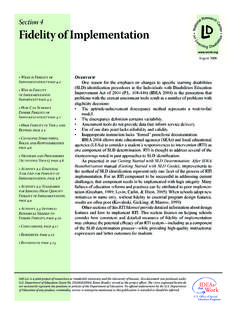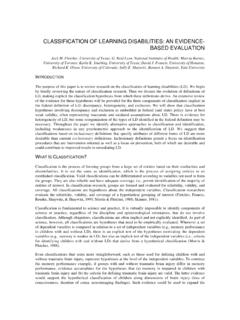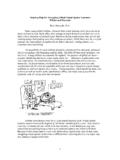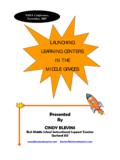Transcription of Reading Methods and Learning Disabilities - LDAofKY
1 Reading Methods and Learning Disabilities Reading instruction is designed to teach two elements of Reading : mechanics and comprehension. While the foundation for Reading begins at birth, the focus of instruction from preschool through third grade is Reading mechanics, and Reading comprehension is the focus from the third grade into early adulthood. It cannot be assumed that a child with Learning Disabilities will master the mechanics of Reading by third grade. Thus, it is critical that appropriate Reading instruction is available throughout his/her school career. Reading mechanics and comprehension comprise various skill levels that are typically taught in a progressive fashion. Skill levels involved in Reading mechanics include pre- Reading , decoding and fluency.
2 Pre- Reading skills build upon an individual's growing range of experiences that develop awareness and appreciation of printed words . Individuals should be encouraged to be aware of words wherever they appear, , on grocery labels, household objects, billboards, and the like. Individuals can acquire a more sophisticated understanding of written language by Learning : the alphabet, including the names, sounds, and shapes of letters, and how to write them;. that English has a left to right directionality;. that words are made up of letters and syllables;. that words are made up of sound elements or phonemes, and by Learning the practical application of the relationship between sounds and their representative letters by counting the sounds in a word, through rhyming games and exercises, phonemic substitutions, and creating nonsense words by substituting or rearranging phonemes (phonological awareness).
3 Decoding Decoding is the process translating a written word into a spoken word ("cracking the code"). An individual who has developed adequate decoding skills can begin to acquire fluency when Reading no longer requires a conscious, deliberate effort. When fluent, Reading becomes automatic and consists of word recognition rather than sounding out and combining syllables necessary to decode words . Teaching decoding provides students with the keys to unlock new words . Teaching the regular phonetic patterns of English can do this. These rules can be applied to words with which the student is already familiar. New words are then introduced beginning with simple words and working through more complex words .
4 Finally, irregular phonemic patterns can be introduced and eventually mastered. Comprehension skills Individuals typically shift their attention to Reading comprehension once they have established appropriate mechanical skills (decoding). Comprehension skills, like mechanical skills, usually build progressively from fundamental to more sophisticated levels. Therefore, it has traditionally been helpful for individuals to learn to read for factual information before they begin to compare and evaluate the information they read. It will normally be easier for an individual to learn to read and comprehend material at these two levels before Learning analysis and synthesis. Reading for factual information requires that the sequence of events and the details of a story be followed so that, for example, it is possible to read a murder mystery and solve the story's dilemma or to understand how it was resolved.
5 Learning to compare and evaluate information from different sources requires the reader to be able to derive the main ideas from a text and isolate its organizing idea or thesis. This fundamental level of critical Reading allows the reader to apply evaluative techniques like comparing and contrasting what was read in order to solve and verify statements. The more advanced critical Reading skills of analysis and synthesis allow the reader to draw salient conclusions and to make reasonable inferences from the information contained in the text. In addition, these skills allow the reader to engage the text with greater sophistication and to evaluate materials for relevance, consistency, and bias. Reading : A Problem for Many Persons with Learning Disabilities For the person with Learning Disabilities , the process of Learning to read can break down with Reading mechanics or comprehension, and at any of the specific skill levels.
6 It is also important to note that children with Learning Disabilities do not always acquire skills in the normal developmental sequence. If an individual does not develop adequate phonemic awareness during the pre- Reading period, effective decoding may not be possible, which influences the development of fluent Reading and comprehension skills. Also, children with Learning Disabilities often come to the Reading task with oral language comprehension problems. When assessing and planning for instruction, consideration of these oral language comprehension problems may facilitate acquisition of Reading comprehension. No single Reading method will be effective for all students with Learning Disabilities .
7 Most individuals with Learning Disabilities will benefit from the application of a variety of Methods . Instructors need a repertoire of instructional Methods . Teachers should be able to appropriately and systematically modify or combine Methods , and utilize different Methods in order to meet an individual's changing needs. Selecting the appropriate program to apply to the student is not a simple matter, and requires a careful assessment of where the student is in the developmental process. It is not uncommon, for example, to observe an individual with all the pre- Reading skills, numerous comprehension skills, and simple decoding skills acquired during the student's progression through mechanical Reading instruction.
8 Because there may be a lack of understanding of the sophisticated decoding skills needed, Reading with fluency suffers. Students with Learning Disabilities should be provided with sound strategic approaches that empower them as readers, rather than be allowed to learn and internalize incorrect practices. Selecting the appropriate method A significant part of selecting appropriate instructional approaches is understanding the Learning profile of an individual. A diagnostic program is necessary to identify students with Learning Disabilities . A cognitive profile is also necessary to determine precisely what students' needs are, their strengths and weaknesses, whether they have difficulty with working memory, if they have inadequate language skills, etc.
9 Students with Learning Disabilities need to be taught strategic approaches explicitly. They need to have ideas made conspicuously clear to them. Persons with Learning Disabilities who need to work on Reading mechanics frequently respond to explicitly taught code-emphasis developmental Reading Methods such as phonic, linguistic, or multisensory approaches. Some of the more popular approaches are briefly described below. Phonics approach. The phonics approach teaches word recognition through Learning grapheme- phoneme (letter-sound) associations. The student learns vowels, consonants, and blends, and learns to sound out words by combining sounds and blending them into words . By associating speech sounds with letters the student learns to recognize new and unfamiliar words .
10 Linguistic method. This method uses a "whole word" approach. words are taught in word families, or similar spelling patterns, and only as whole words . The student is not directly taught the relationship between letters and sounds, but learns them through minimal word differences. As the child progresses, words that have irregular spellings are introduced as sight words . Multisensory approach. This method assumes that some children learn best when content is presented in several modalities. Multisensory approaches that employ tracing, hearing, writing, and seeing are often referred to as VAKT (visual, auditory, kinesthetic, tactile) Methods . Multisensory techniques can be used with both phonics and linguistic approaches.
